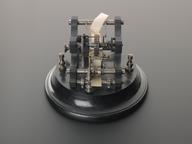

Replica of the first Morse telegraph, 1835
- maker:
- Deutsches Museum and
- Samuel Finley Breese Morse

Replica of Morse's first model of telegraphy apparatus of 1835, possibly made by the Deutsches Museum, Munich, Germany, 1934.
This is a replica of Samuel Morse's first model of telegraphy apparatus from 1835. Morse was one of the pioneers of electric telegraphy. Prompted by receiving news of his wife's death too late to attend her funeral, Morse was determined to improve the speed of long distance communications (which at that point relied on horse messengers). Morse invented an instrument that used a current to displace an electro-magnet, which moved a marker, therefore recording the breaks in the current - the invention of Morse Code. At the same time, Cooke and Wheatstone were working on their own electric telegraph in England. Although Morse claimed to conceive the idea earlier, Cooke and Wheatstone were in 1837 the first in the world to patent an electric telegraph system. Morse maintained that he was the true inventor of the electric telegraph, as only his instruments were able to record messages as well as receive them. He asserted that Cooke and Wheatstone's instruments were merely electrical semaphores. Morse was an artist and he used framing materials in putting together this first apparatus.
Details
- Category:
- Telecommunications
- Object Number:
- 1934-544
- Materials:
- wood (unidentified), metal (unknown) and paper (fibre product)
- Measurements:
-
receiver: 1105 mm x 1100 mm x 385 mm, 4.5 kg
transmitter: 180 mm x 1200 mm x 170 mm, 1.5 kg
- type:
- telegraph
- credit:
- Purchased from the Deutsches Museum




